Places of interest

| The Daimon (Great Gate) | Danjo Garan | Koyasan Reihokan Museum | Mount Koya Taishi Kyokai |
| Nyonindo | Tokugawa Clan Mausoleum | Karukaya-do | Okunoin |
The Daimon (Great Gate)
This large gate marks the entrance to Mount Koya. Originally, the central gate was a “torii” gate located further down in the winding valley below. That gate burned down from forest fires and lightning, and it was rebuilt in its current location in 1705. The two-tier tower spans across five section and is 25.1 meters tall. It is flanked by two Vadrajhara figures; they are considered to be the second largest such figures in Japan, after those at Todaiji, and are the work of Edo-period sculptors. An inscription reads: “Kobo Daishi appears each morning, makes the rounds, and offers us salvation,” expressing the idea that Kobo Daishi is always with us. To the side of the Daimon is the entrance to Bentendake. At the top of that mountain is enshrined Dake-no-benzaiten, whom Kobo Daishi had ceremonially transferred there.
For details on the inscription, see the Yomoyama collections in the Reihokan (sacred treasures collection).Opens in a separate window.
Danjo Garan
When Kobo Daishi first opened Mount Koya as a monastery, this was the first site built. Kobo Daishi himself leveled the soil and poured his energies into building the towers and halls that would form the basis of esoteric Buddhist studies here. The Danjo Garan is said to express the world depicted in the Womb Realm Mandala.
The remaining locations here are introduced in the order described in the ancient Ryodan Nyodo, which describes the correct order in which to pay homage to these sites. We highly recommend visiting them in that order.
-
Chumon
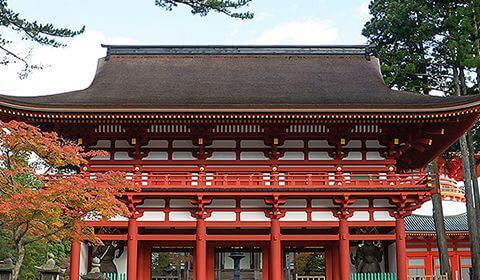
This twin-tiered, five-sectioned tower stands at the lowest point before the entry to the Kondo. Following a large fire in Tempo 14 (1843), the Garan Danjo burned to the ground, save for the easternmost tower. The original Chumon gate was lost at that time, and for many years it was not restored. For the first time in 170 years, celebrating the 1,200th anniversary of Mount Koya’s founding, it has been rebuilt. Four figures are consecrated here: Jigokuten, Tamonten, Komokuten, and Zochoten. Jigokuten and Tamonten date to the original Chumon gate and were spared the fire. They have been preserved and restored up to the present. Komokuten and Zochoten are new originals courtesy of Myokei Matsumoto, a master Buddhist sculpture carver.
For details, see the Yomoyama collections in the Reihokan (sacred treasures collection). Opens in a separate window.
-
Kondo
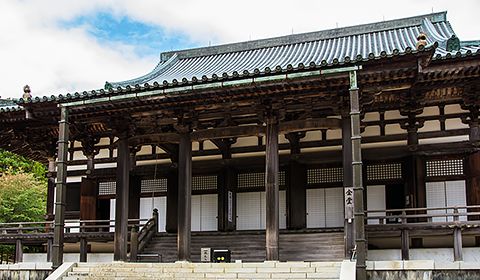
When Kobo Daishi first opened Mount Koya, this was the building that, following the main temple, was first constructed. At the time, it was referred to as the Kodo. Since the middle Heian period, it has served a key role as the central hall on Mount Koya. The current building is the seventh reconstruction and was completed in Showa 7 (1932). The transverse beams are 23.8m long, while those perpendicular are 30m long. The building is 23.73m tall and contains a gabled, hipped roof. It was designed and constructed by Goichi Takeda, considered the father of modern architecture in western Japan, and uses a ferroconcrete core out of consideration towards the earthquakes and fires that had razed the building in the past. The interior frescoes were painted by master painter Fuzan Kimura, who studied unrder Tenshin Okakura, himself responsible for major developments with the Japanese Academy of Fine Arts. These works are Shakajodo Kyogakukaiji and Hakkuyo Bosatsuzo. The principal object of worship is an image of Akshobhya and was created by Koun Takamura, a sculptor who took interest in Western traditions of photorealism in sculpture. He incorporated photorealism in wood carving, ushering in modernization to what had been the prevailing style until the Edo period.
For details, see the Yomoyama collections in the Reihokan (sacred treasures collection).Opens in a separate window.
-
Toten no Matsu and Shakushi no Shiba
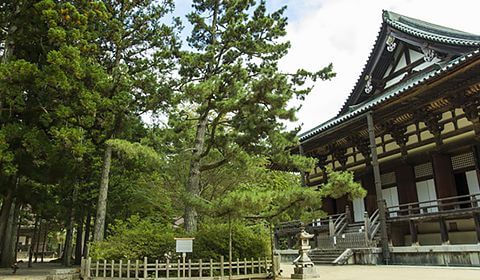
The pine tree (matsu) to the west of the Kondo is called Toten no Matsu. A monk named Nyoho from Myo’o-in, a temple north of the Danjo Garan, ascended to Maitreya’s Pure Land in 1149 at the site of this tree. One of his disciples, who happened to be preparing the morning meal, saw his teacher’s ascension and hurried to the three to follow him to the Pure Land. He was holding a ladle (shakushi), which fell down to earth as he, too, ascended. At the time, this area had a grassy lawn (shiba), which is where the ladle fell. This is where the name Shakushi no Shiba comes from.
For details, see the Yomoyama collections in the Reihokan (sacred treasures collection).Opens in a separate window
-
Rokkaku Kyuzo (hexagonal depository of the scriptures)
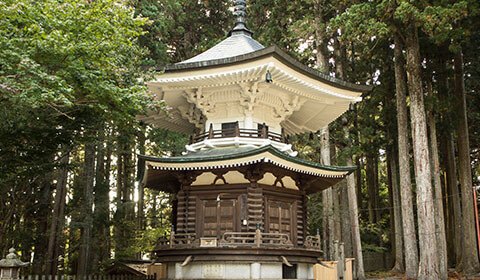
Bifukumon-in, empress consort of Emperor Toba, had this edifice built to pray for her husband’s happiness in the next world. Once housed inside was a complete copy of the scriptures, inscribed in gold ink on blue paper. To pay for the cost of these scriptures, Bifukumon-in pledged her manor in Kishu Arakawa (present-day Momoyama-cho, Naka-gun. For this reason, the scriptures are referred to as the Arakawa Scriptures. Similarly, this edifice is also sometimes called the Arakawa Scripture House. The site was rebuilt in February 1934. There are handles near the base, which can be rotated. This is done to denote that one has completed the pious act of reading the scriptures once through.
For details, see the Yomoyama collections in the Reihokan (sacred treasures collection).Opens in a separate window
-
Miyashiro
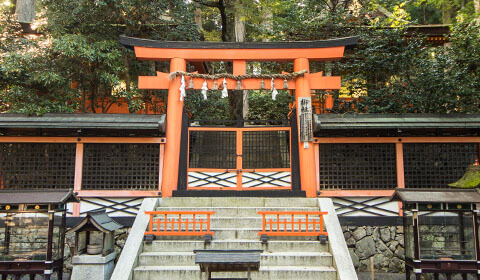
In the tenth year of Konin (819), Kobo Daishi transferred the titular deity from Tenno-sha to Mount Koya. As the anecdotes of the opening of Mount Koy indicate, the mountains were originally the province of Niu Shrine. As Kobo Daishi preached the teaching across Japan, his ideas gained respect and support among the local deities, and this spurred on the syncretism of Shinto and Buddhist traditions. Support and faith for Shisha-Myojin Shrine is considered a crucial aspect of this area, as the shrine is held to protect practitioners who come to the mount. There are three main buildings: the first is Niu-Myojin, the second is Koya-Myojin, and the third is a shrine that is dedicated collectively to 12 princes and 120 gods. Niu- and Koya-Myojin are built using the traditional Kasuga-zukuri style, while the third shrine features Sangensha Nagaremisedana-zukuri construction. All of the buildings use thatched roofs made from hinoki bark. The current shrine complex is a reconstruction of the original built in Bunroku 3 (1594) and is designated as an important cultural asset.
-
Sanno-in
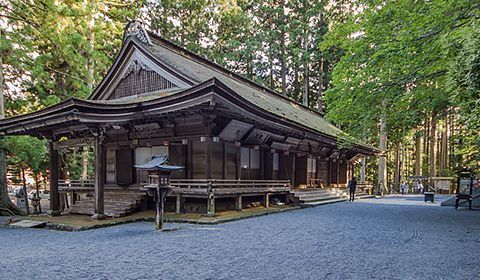
Sanno-in was built as a hall of worship on Mount Koya and features a gabled, hipped roof with transverse beams 21.3 meters long and perpendicular beams 7.8 meters long. The name “”Sanno-in”” refers to the local Shinto deity being revered as a “”god of the mountain.”” The current building was reconstructed in Bunroku 3 (1594). Important rites and dialogues are held yearly at Sanno-in. On the 16th of every month, a service is held honoring the deity here.
-
Saito (West Tower)
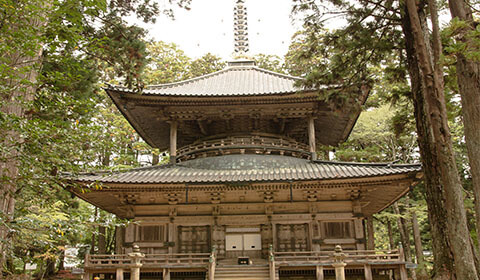
This edifice was built by Shinzen Daitoku, the successor to Kobo Daishi, based on the latter’s plans for the Garan. Kobo Daishi’s idea was to utilize the Daito and Saito pagodas as representations of the esoteric world of Vairocana. However, the construction was ultimately delayed and not completed until the second year of the Ninna era (886). While the Daito enshrines an image of Vairocana in the Womb Realm, Saito has images of both the Womb and Diamond Realms. The current tower was rebuilt in Tempo 5 (1834) and features an ornamental knob at the top. The pagoda is 27.27 meters tall.
For details, see the Yomoyama collections in the Reihokan (sacred treasures collection).Opens in a separate window
-
Kujaku-do
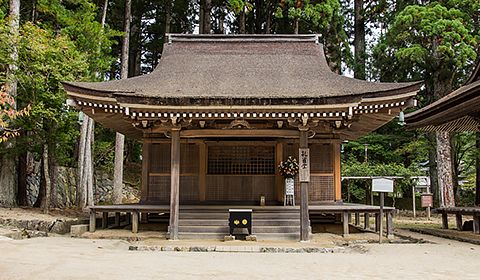
In the first year of Shoji (1199), Engo, the head abbot of Toji, performed a prayer for rain at Shinsen-en at the request of Emperor Go-Toba, and the prayer was answered. This act was to be consecrated on Mount Koya, and the following year, the miracle was enshrined at this site. In the first year of Showa (1926), a large fire spread from Kondo and burned this site, but it was rebuilt in 1983 as part of the commemoration of the 1,150th anniversary since Kobo Daishi entered the next realm. The enshrined image of Mahamayuri is designated as an important cultural asset and is currently stored at the Reihokan.
For details, see the Yomoyama collections in the Reihokan (sacred treasures collection).Opens in a separate window
-
Sakasahi no Fuji (Inverted Wisteria)
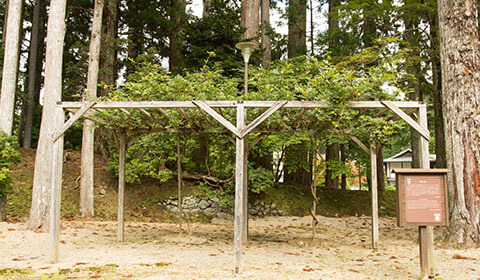
The high priest Kishin was active in the Heian period and was an ardent follower of the Lotus Sutra. In the fifth year of Chowa (1016), Kishin went to Mount Koya, but the site at the time was in disrepair. Kishin vowed to revitalize the mount and, as an act of piety, planted wisteria sprouts upside down along the road. Amazingly, these sprouts bloomed, and Mount Koya began to regain its original vitality. Kishin was thus seen as the steward of Mount Koya’s rebirth and was followed by many as the reborn form of Kobo Daishi.
For details, see the Yomoyama collections in the Reihokan (sacred treasures collection).Opens in a separate window
-
Junteido
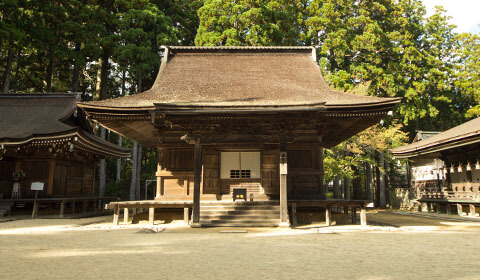
The Cundi image enshrined here is said to have been created by Kobo Daishi himself upon his entering the priesthood. When the Garan was built, this Cundi image was installed in the eating quarters. In Tenroku 4 (973), with the creation of the Junteido, the image was moved. Although this edifice burned down many times, the latest incarnation was rebuilt in Meiji 16 (1883). Every year on July 1st, a special service revolving around the Cundi image is held here.
For details on the annual Cundi service, please see the Annual Eventspage.
-
Miedo (Great Portrait Hall)
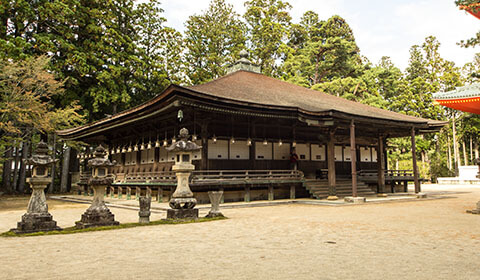
Originally Kobo Daishi’s own training hall, this site was later used to enshrine an image of Kobo Daishi created by Takaoka Shinno, at which time it was given the name of “”Great Portrait Hall.”” The transverse and perpendicular beams are 15.1 meters long, and the hall is lined with images of ten of Kobo Daishi’s disciples. The Miedo is considered the most sacred location on Mount Koya, and only a select few were originally permitted to enter. However, on the night before the Chinese New Year (March 21), following a special service, lay visitors are permitted to enter the outer sanctum.
For details, see the Yomoyama collections in the Reihokan (sacred treasures collection).Opens in a separate window
For details on the Lunar New Year event, please see the Annual Eventspage. -
Sanko no Matsu (Trident Pine)
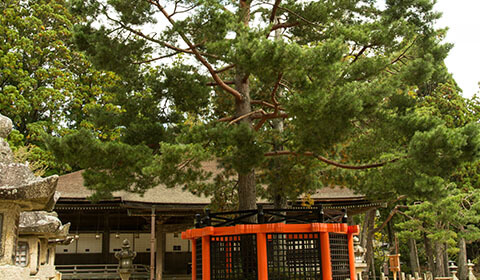
Between the Kondo and Miedo you will see a pine tree surrounded by a fence. There is an interesting anecdote concerning this tree. When Kobo Daishi prepared to return from T’ang China, he threw a vajra trident (sanko) from China towards Japan as a means of divining the ideal site to promote Shingon Buddhism in Japan. Purple clouds emerged and carried the trident to Japan. When Kobo Daishi later made his visit to the Koya area, he heard from local hunters that there was a nearby tree that glowed every night. He went to the tree and found the trident stuck in it. So amazed was he that he decided this would be the site to bring Shingon Buddhism to Japan. Like the trident itself, the pine tree had three-pronged leaves, so it was dubbed Sanko no Matsu (Trident Pine) and treated as a sacred site. Visitors today treat leaves fallen from this tree as talismans and keep them as lucky charms.
For details, see the Yomoyama collections in the Reihokan (sacred treasures collection).Opens in a separate window
-
Konpon Daito
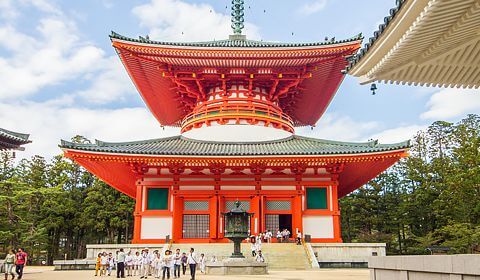
Konpon Daito: Kobo Daishi and his successor Shinzen Daitoku devoted themselves to the construction of this pagoda, which took from 816 through 887. Kobo Daishi referred to this pagoda as a representation of the universe, and, as it played a role as the central training dojo for the Shingon Sect, it was called the Konpon (principal) Daito. This is believed to be Japan’s first square two-storied pagoda. It enshrines an image of Vairocana in the womb real and is surrounded by four Buddhist figures from the Diamond Realm. The sixteen pillars that support it are inscribed with images of sixteen boddhisatvas, drawn by Insho Domoto. Images of the eight patriarchs who spread the teachings of esoteric Buddhism can be found in the four corners of the interior, with the inside of the pagoda itself forming a mandala.
For details, see the Yomoyama collections in the Reihokan (sacred treasures collection).Opens in a separate window
-
Taimen-zakura
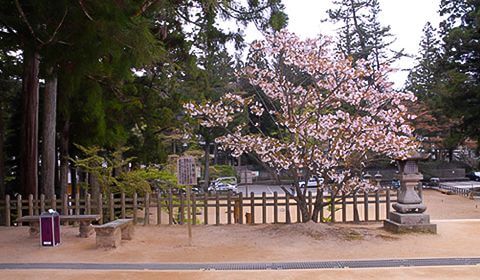
According to ancient records, cherry trees used to bloom in front of the Daito and around the east side of the Kondo. In the Heian period, the Daito burned down when it was struck by lightning. For its rebuilding, Taira no Kiyomori was appointed to partake in the construction as a form of training, and he built a fabulous pagoda. Following the construction, he ascended the mountain for a prayer service. An old monk appeared before him at the foot of the cherry trees. The monk said, “”The completion of the pagoda is an auspicious event…However, if you engage in misdeeds, your children and their children will never have their wishes answered.”” Some time later, the figure disappeared. Kiyomori is said to have been deeply impressed by this, wondering if the figure was Kobo Daishi himself. In this way, because Kobo Daishi appeared by the cherry tree and met (“”taimen””) with Kiyomori, this spot is called Taimen-zakura.
For details, see the Yomoyama collections in the Reihokan (sacred treasures collection).Opens in a separate window
-
Daito Bell and Koyashiro
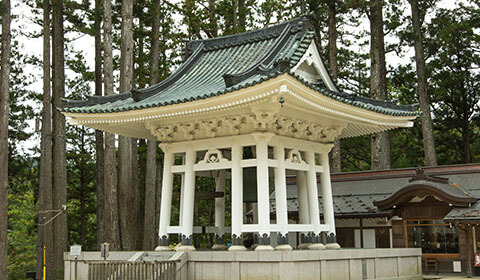
Kobo Daishi determined to cast a bell here, and it was finally completed in the era of his successor, Shinzen Daitoku. The current copper bell was built in Tembun 16 (1547) and has a diameter of 2.12 meters, making it the fourth largest bell in Japan. The name “Koyashiro” is a play on the name of the mountain and the name given to one’s fourth son. The bell keeps time five times during the day, being rung at 4:00 AM, at 1:00 PM, at 5:00 PM (during the spring equinox, at 6:00 PM), at 9:00 PM, and at 11:00 PM.
For details, see the Yomoyama collections in the Reihokan (sacred treasures collection).Opens in a separate window
-
Aizendo
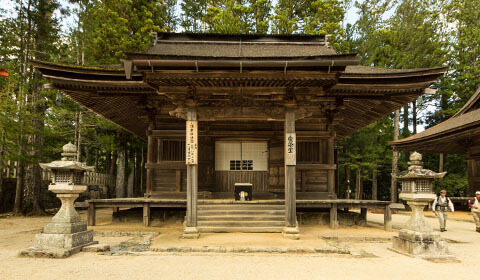
In the first year of Kenmu (1334), Emperor Go-Daigo ordered that this pagoda be built as a prayer for world peace and the health and longevity of the emperor. Enshrined is an image of Ragaraja, its proportions are said to be based off of Emperor Go-Daigo himself. This pagoda was originally called “”Shingakudo”” and was the site of prayer rituals. The building was damaged and destroyed over the years. Its current incarnation was built in the first year of Kaiei (1848).
-
Fudodo
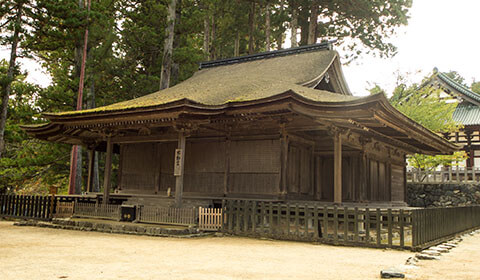
In Kenkyu 8, (1197), Hachijo Nyoin, daughter of Emperor Go-Toba and imperial princess, had this pagoda built by Gyosho. Originally located in Isshin-in-dani (the current site of Kinrinto), the pagoda was later moved to the Garan. The current building was rebuilt in the early 14th century. Each of the four corners of the tower is different; this is believed to be because the four craftsmen who engaged in the construction each took their own approach. It is presumed that this hall was originally used to enshrine an image of Amhitaba, but it now enshrines Acala and his eight attendants. The eight attendants are famous as pieces by the sculptor Unkei, and they are now housed in the Reihokan Museum.
-
Kangakuin
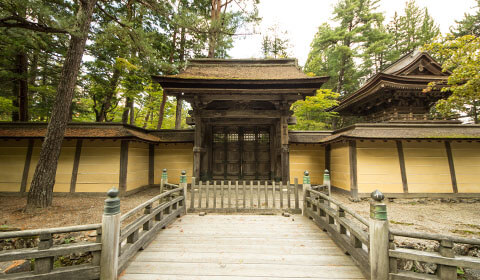
Hojo Tokimune created this site within Kongo Sanmai-in as a training hall for the monks on Mount Koya. In year two of the Bumpo era (1318), Emperor Go-Uda decreed that it be moved to the site it now occupies. Enshrined here is an image of Vairocana. The site is still used as a training ground for the annual Kangakue, with entrance not permitted to the public.
-
Hasu-ike (Lotus Pond)
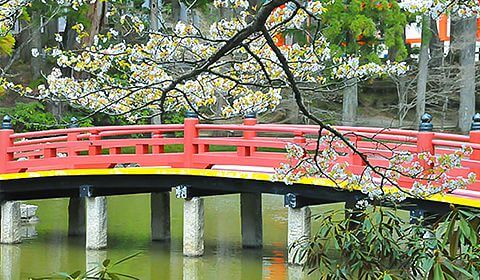
This pond, found in front of Kangakuin, is called Hasu-ike. Until the Showa period, beautiful lotus blossoms bloomed here. The pond is also home to a small shrine. Sometime in the Meiwa era, a long drought continued, causing the people to suffer. Seeking to alleviate this, in the eighth year of Meiwa (1771), Jiko Suizoin donated an image of Dragon King Zennyo and Buddha’s ashes, which were enshrined in a small altar built on the island in the middle of the pond. This act caused a miraculous virtue that cleared the drought. In Heisei 8 (1996), the bridge and altar were repaired. Every October 17, scriptures are read at the site.
For details, see the Yomoyama collections in the Reihokan (sacred treasures collection).Opens in a separate window
-
Daiedo
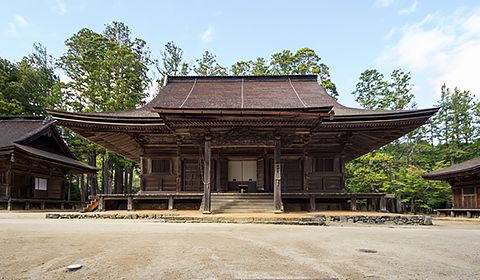
Gotsuji Saiin, imperial princess under Emperor Toba, had this hall built in honor of her father. It was originally located elsewhere, but it was moved to the Garan as the site of certain rituals, where it came to be called the Rengejoin. Currently it acts as a gathering hall when services are held. The current building was reconstructed in the first year of Kaei (1848). It enshrines an image of Amitabha, flanked by images of Avalokitesvara and Mahasthamaprapta.
-
Sanmaido
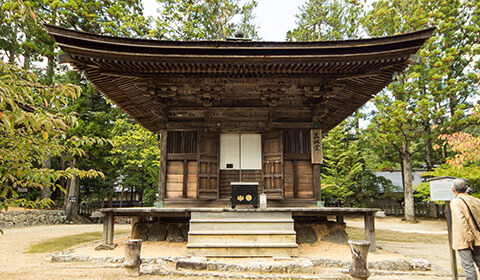
Head priest Saiko (870-942) had this hall built in the seventh year of Encho (929). It was originally located within the precinct of Soji-in. Saiko carried out the “”rishu zanmai”” rite here, so it came to be called the Sanmaido. The hall was later moved to the Garan, where it is said that Saigyo Hoshi was involved in the construction. The cherry trees in front of Sanmaido are called Saigyo-sakura after Saigyo himself, who is said to have planted them. Legend has it that he planted the trees to commemorate the completion of the hall. The current building was reconstructed in Bunka 13 (1816).
For details on the Saigyo-zakura, see the Yomoyama collections in the Reihokan (sacred treasures collection).Opens in a separate window
-
Toto
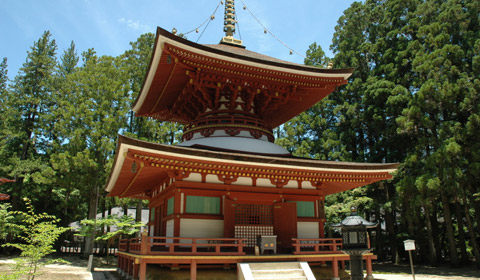
In the second year of Daiji (1127), Emperor Shirakawa had this pagoda built by Daigo Sanboin Shokaku Gon no Sojo. At the time, a rendering of Usnisavijaya in the image of the emperor was enshrined here, with Acala and Trailokyavijaya Vidya-raja flanking it. In Tempo 14 (1843), the building burned, and it went without being rebuilt for 140 years. In Showa 59 (1984), it was finally constructed anew.
-
Chisenbyo
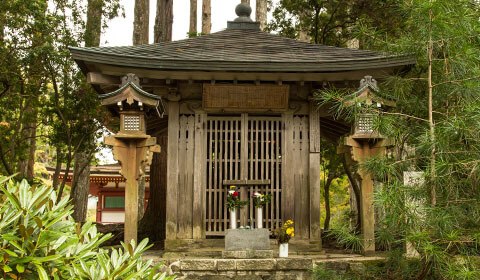
Travel east of Toto and you arrive at a small, quiet temple. This temple honors Kobo Daishi’s nephew, Chisen Daitoku (789-825). Considered highly talented from a young age, he followed Kobo Daishi and entered T’ang China. However, Chisen Daitoku left this realm at the young age of thirty-seven. Kobo Daishi deeply grieved this loss and created a grave for him.
-
Jabara-michi
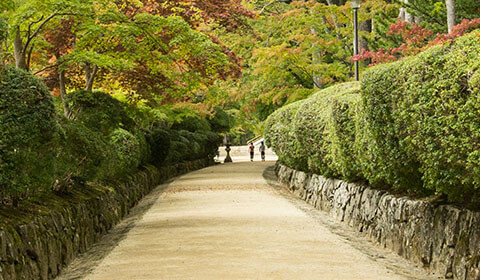
The small path that winds its way from the entrance to the Garan towards the east side of the Toto pagoda is called Jabara-michi. Kobo Daishi likened Mount Koya’s layout to the belly of a reclining dragon: the Danjo Garan is the head, with the area spanning up to Rengein being the figure of a dragon. The Jabara-michi happens to fall around where the dragon’s stomach would be, which is what the name of the path means (technically “snake’s belly,” and also the word appropriately used to describe camera bellows.)
-
Rokuji no Kane
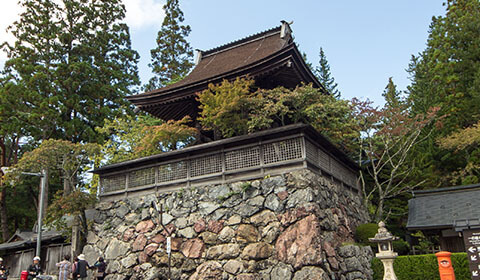
Enclosed behind a tall stone wall at the entrance to the monastery is this bell tower. It was built by Masanori Fukushima in the fourth year of the Genna era (1618) as a wish for his parents’ repose in the next realm. Fukushima is known as one of the “”Seven Spears”” from the battle of Shizugatake between Toyotomi Hideyoshi and Shibata Katsuie; in other words, he was one of the most fearless generals of the Toyotomi clan. In Kan’ei 7 (1640), Masanori’s son, Masatoshi, recast the bell. It is famous for being an early example of a proper name that features the native Japanese syllabary alongside Chinese pronunciation. Even today, the bell is rung between 6:00 AM and 10:00 PM on the even hours, announcing the time.
Koyasan Reihokan Museum
The Reihokan Museum stores and protects sacred relics from Konboguji, as well as the numerous Buddhist images, icons, and other cultural assets that have existed at this temple. In addition to functioning as a space for storage and curation, it also features a general museum that was built in Taisho 10 (1921) in order to bring these artifacts to a wider public. The building is styled after Byodoin in Uji, and it is one of the few rare Taisho-era structures on Mount Koya designated by the Japanese government as a cultural property.
For details on opening hours and other information, please see the Koyasan Reihokan Museum site(opens in a separate window).
Mount Koya Taishi Kyokai
This is the central site for the promotion of Koyasan Shingon Buddhism, hymns, and Shingon dance. Various workshops and study sessions are also held here. Daikodo was constructed in Taisho 14 (1925), the 1,100 year anniversary of Mount Koya’s founding. Enshrined therein is an image of Kobo Daishi, flanked by images of Ragaraja and Acala.

The Daikodo has a sutra hall at the back in which you can learn the ten precepts (Buddhist ways of thinking that you can use in everyday life) from a high monk.
For details on how to participate in sutra sermons and shakyo copying, visit the Participate page.
Nyonindo
In ancient times, there were nine entrances to Mount Koya, dubbed Koya-nanakuchi. In Meii 5 (1872), the ban on women entering the precinct was lifted. Until that time, women were strictly forbidden, so there were special prayer sites exclusively for them at each entrance. These were called Nyonindo. Today, there is only one Nyonindo that has survived the ravages of time.
Tokugawa Clan Mausoleum
In Kan’ei 20 (1643), Tokugawa Iemitsu, the third generation shogun of the Tokugawa clan, had this mausoleum built. Two identical buildings join at their central apex. When facing the mausoleum, the building at right is for Tokugawa Ieyasu, and the building at left is for Tokugawa Hidetada. To the east of the mausoleum was once a mortuary chapel for the third generation Tokugawas and beyond, but it burned down in Meiji 21 (1888).
Karukaya-do
The story of Karukaya-doshin and Ishidomaru is a well-known tragic tale. This pagoda is said to be where Karukaya-doshin and Ishidomaru entered the priesthood and trained together, not revealing their relationship as father and son.
Okunoin
One of the central pillars of faith on Mount Koya, this is said to be where Kobo Daishi entered the next world.
-
Torodo
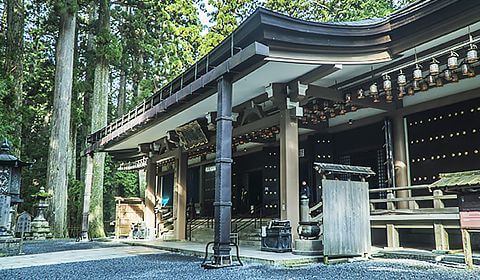
Built by the second generation successor of Koyasan, Shinzen Daitoku. In Jian 3 (1023), Fujiwara no Michinaga had it scaled to approximately the size it is today.
The building houses the Kishinto, a lantern offered by Kishin that remains always lit. There is also the Shirakawato offered by Emperor Shirakawa, and the Hinnyo-no-Itto, which a poor woman in ancient times dedicated to the temple at Kishin’s advice, cutting her precious black hair and selling it to afford the cost. Lastly, there is the Showato, a lantern dedicated by the Emperor and Royal Family in the Showa period. These lanterns remain always lit.
Parishioners can come here to say prayers and have blessings conferred.
Torodo Opening Hours
<Torodo Opening Hours>
Normally: 6:00 AM to 5:00 PM
New Year’s Day: doors reopen from midnight to 2:00 PM Mandokuyo’e: for the Mandokuyo’e on August 13, doors reopen from 7:00 PM to 9:00 PM
Mando’e: for the Mando’e on October 1 through 3, doors reopen from 7:00 PM to 9:00 PM<Ticketing:>
Reception booth is open from 8:30 AM to 5:00 PM. Booth will also be open during opening hours on 1/1, 8/13, and 10/1–10/3.Memorial Services
<Opening hours>
8:30 AM to 4:30 PM. No reservations required.<Sutra chanting service schedule:>
Memorial services with sutra chanting are held six times a day at the Torodo.
Note that times may be subject to change when other events are being held.First service: 9:00 AM
Second service: 10:20 AM
Third service: 11:30 AM
Fourth service: 12:40 PM
Fifth service: 1:40 PM
Sixth service: 2:40 PMWe also accept prayer offerings for the first three days of the new year, but because of other schedule New Year rites, the actual services begin on the 4th.
Prayers
<Opening hours>
8:30 AM to 4:30 PM. No reservations required.Prayer and memorial fees
For details on prayer and memorial fees, please download the PDF here.
*Special homa stick prayers require a reservationPrayer and memorial fees (PDF file 56KB)
Adobe Acrobat Reader is required for download
Get Adobe Acrobat Reader from the link below -
Mausoleum of Kobo Daishi
This is one of the most sacred sites for followers of Kobo Daishi around Japan. He entered deep meditation in order to save us through eternity, and he remains at this site, ever praying for our salvation.
-
Shotokuden Tea Hall
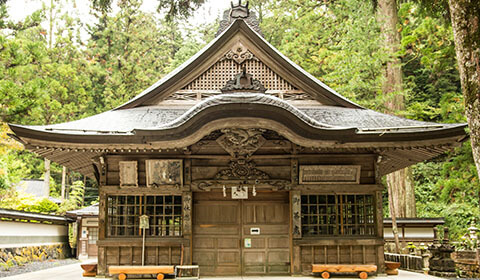
Shotokuden Tea Hall Built in Taisho 4 (1915) to commemorate the 1,100 year anniversary of Mount Koya’s founding. This is one of the few Taisho-era buildings at Koyasan. Originated by a temple in Wakayama City, this hall is the result of many generous donations.